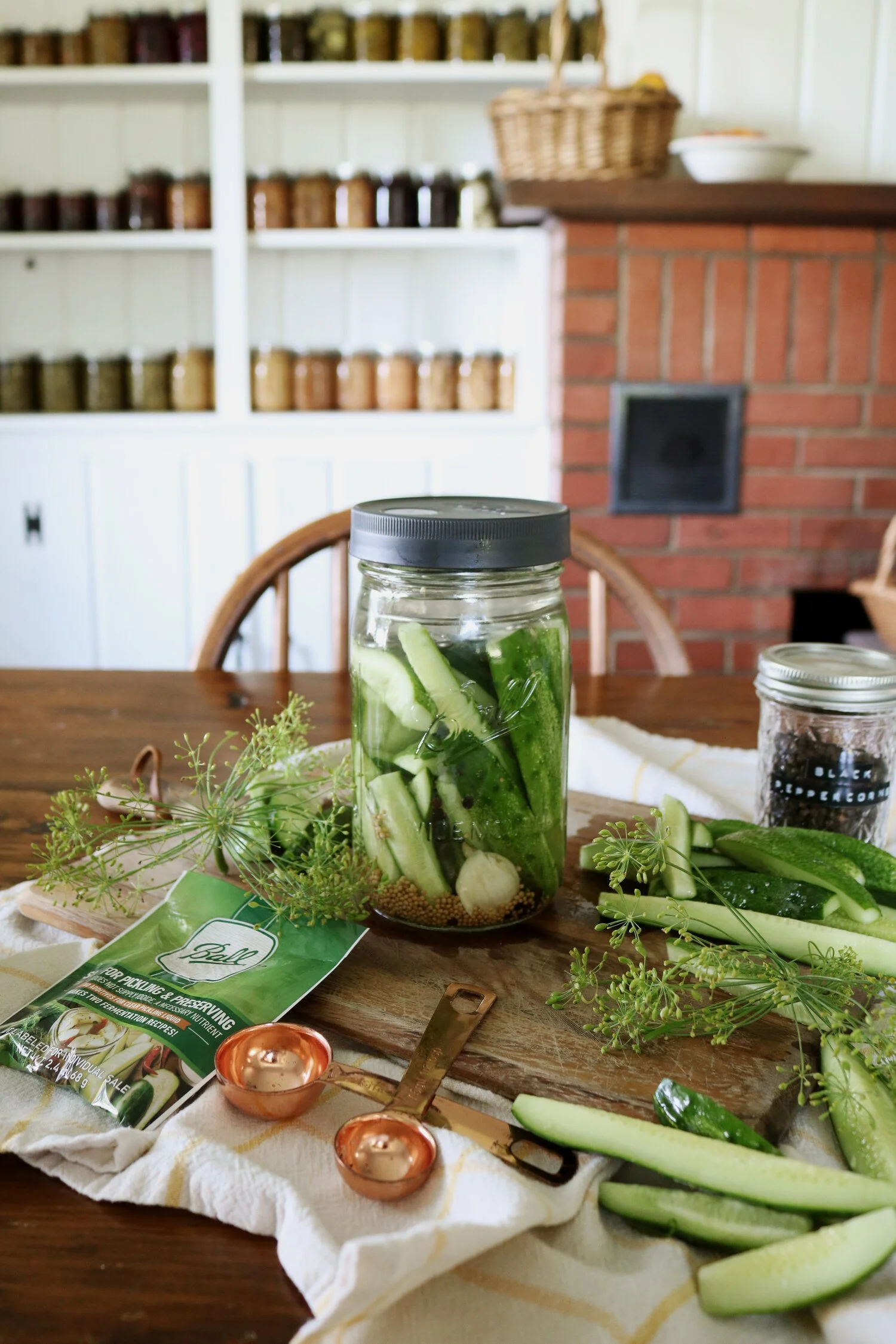Fermented Easy Brined Cucumber Pickles with Ball® Canning
I am so excited to share this recipe! I have been wanting to try fermenting pickled cucumbers for a couple of years now, and it gives me such pleasure to work with Ball® Canning as one of their canning ambassadors, because that means I get to try new things like this. I just cracked open my jar the other day, and they are absolutely delicious. Why have I never tried fermenting pickles before?! If you are considering trying this yourself with your garden cucumbers, I highly recommend it. All you need is the new Ball® Fermentation Kit, which makes fermenting for beginners incredibly easy and worry-free.
This recipe is originally via Ball® Fresh Preserving’s website, which you can find by clicking here.
fermentation faqs:
VIA BALL® FRESH PRESERVING
Choose fresh, healthy produce.
Before starting recipe, thoroughly wash hands, ingredients, equipment, and countertop.
Do not alter salt, produce, or water proportions. Salt is critical to prevent undesirable bacteria growth. The brine, or salt-water mixture, is set to a specific proportion to prevent undesirable bacteria growth
Do not alter recipe duration times. Do not taste fermenting food too early. Do not leave the fermented food out of the refrigerator longer than the maximum duration specified in recipe.
Only use canning or pickling salt that does not contain iodine and anti-caking agents.
Keep jar covered with cloth to block sunlight, and store in a cool, dry environment. Room temperature (68°F-72°F/20°C-22°C)) is optimal for fermentation.
Periodically check ferment to ensure that all food remains fully submerged under brine.
HOW DOES PICKLING SALT DIFFER FROM TABLE SALT?
Pickling salt, such as Ball® Salt for Pickling and Preserving, and natural sea salts are free of additives and ensure you are using the best product for fermentation.
IS CLOUDY BRINE AN ISSUE?
No. Cloudy brine is a sign that fermentation is taking place.
WHAT ARE THE SIGNS THAT THE FERMENT IS BAD, AND I SHOULD DISCARD THE FOOD?
Visible mold, putrid smell, foaming, or unusual color changes. When in doubt, throw it out.
HOW TO TELL THE DIFFERENCE BETWEEN MOLD AND KAHM YEAST?
Mold has a fuzzy appearance and can be shades of green, grey, pink or white. It grows in spots or clumps and often has tentacles that reach well into the ferment. Kahm yeast is a safe, naturally occurring smooth white film that can form on the top of a ferment and inside the upper edges of the jar. kahm yeast smells yeasty, like bread.
IS IT OKAY IF A COUPLE OF PIECES OF FOOD FLOAT TO THE TOP OF THE BRINE?
Yes, but discard them when you open the jar. These pieces may not be safe to consume because they were exposed to air.
ingredients & recipe:
MAKES ABOUT 1 QUART JAR (32 OZ / 946 ML)
3 cups non-chlorinated water, such as spring or filtered
1 1/2 tbsp Ball® Salt for Pickling and Preserving
1 lb fresh medium-sized Kirby pickling or small Persian cucumbers, about 6-7
Optional: 2 cloves crushed garlic, 1 cup fresh dill sprigs or one dill head, 2 tsp mustard seeds, 1 tsp black peppercorns, 1 tsp hot pepper flakes
To make additional brine: dissolve 1 tsp Ball® Salt for Pickling and Preserving in 1/2 cup non-chlorinated water
directions:
To make brine, combine 3 cups water and 1 1/2 tbsp salt to dissolve. Set aside.
Wash the cucumbers and slice 1/16th inch off both ends. Slice cucumbers lengthwise into halves or quarters.
Pack cucumbers, and any optional seasonings, into clean jar. Make sure there is at least 2 inches of headspace. If necessary, slice off top ends of cucumbers to ensure proper headspace. Pour salt water brine over the cucumbers to cover by 1 inch. You may have extra brine leftover.
Place spring on top of cucumbers, then twist lid on.
Wipe down jar and cover with a cloth. Store in a cool place (68-72 degrees F).
Check daily to make sure vegetables remain submerged in the brine. After 24 hours, you will notice visible bubbles on the top of the brine.
Let pickles ferment for at least 1 week. Remove the lid and spring. Remove 1 pickle to taste. If the flavor is to your liking, proceed to next step. If you would like a stronger flavor, ferment the pickles for an additional 2 weeks, tasting every 3 or so days. Wipe jar rim before replacing spring and lid.
Once the desired flavor is reached, remove spring and add more fresh brine if necessary to cover by 1 inch. Wipe jar rim before replacing lid or use a traditional Ball® canning lid or Ball® Leak-Proof Storage lid. Store in refrigerator for up to 6 months.
With the Ball® Fermentation Kit, this recipe felt so much safer to follow and try for the first time. I really enjoyed the spring, which helps keep all of the cucumbers submerged under the brine, and the lid has an excellent special filter on top to allow air flow!
A while back, someone asked me what the difference between hot water bath pickles and fermented pickles was. Aren’t all pickles fermented? Technically, no! Fermented pickles do not have any acidic agent added to the brine, like vinegar. They create their own acidic agent over time by sitting in salt water! This makes fermented pickles the healthiest option for your body over hot water bath pickles. Fascinating! Will you be trying this recipe out?
xoxo Kayla
This post is sponsored by Ball® Canning














